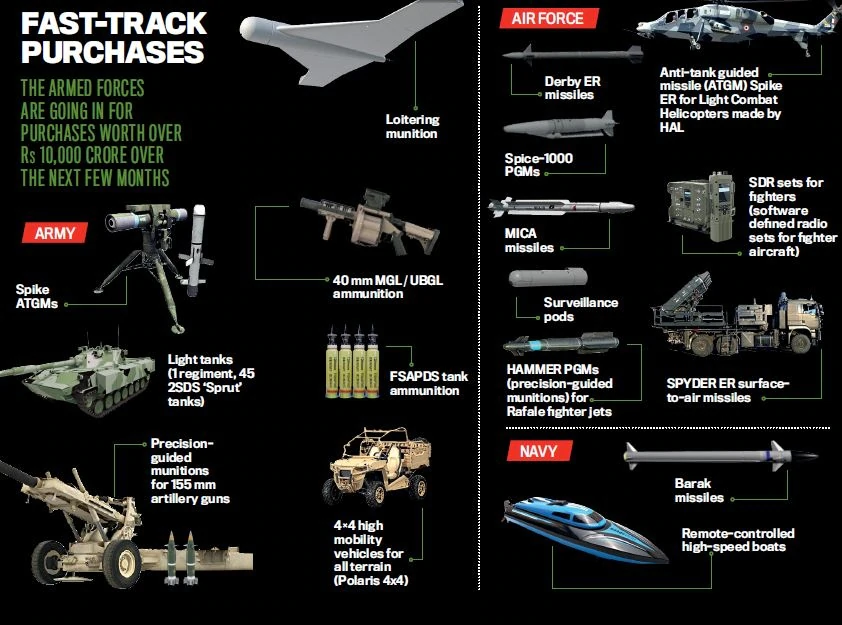HAL Roll Out 1st Light combat helicopter LSP with Improve Aerodynamic
source : https://defenceview.in/hal-roll-out-1st-light-combat-helicopter-lsp-with-improve-aerodynamic/
Good News HAL (Hindustan aerospace limited) started the ground run of The first Light Combat Helicopter limited series production yesterday in Bengaluru.
In a double assertion of its proficiency in building different kinds of helicopters, Hindustan Aeronautics Ltd (HAL) on Monday achieved two significant landmarks: The company rolled out its 300th Dhruv advanced light helicopter (ALH) for the military; and also conducted the inaugural ground run of the first Light Combat Helicopter (LCH) it is series-producing for the Indian Air Force (IAF).
Read Here the full details of HAL LCH : Light Combat Helicopter Of India
FIRST ON LIVEFIST: The first Light Combat Helicopter limited series production (LCH-LSP) airframe on on its first ground run yesterday in Bengaluru.
https://t.co/XmT9EXYIZW pic.twitter.com/etzKkB8HFt
— Livefist (@livefist)
September 30, 2020
While the Dhruv, with over 280,000 flying hours logged, is already the backbone of the IAF and army’s light helicopter fleet, the LCH is a crucial new induction that would play an important role in any armed confrontation between Indian and Chinese troops on the Ladakh border, or in the looming militarization of the Line of Actual Control (LAC).
Improvement
LCH LSP 1 (credit :livefistdefence.com)
HAL LCH first prototype
The HAL changes some minor aerodynamic design in LCH , you can clearly seen in above two pictures .
1-They change the position of engine exhaust pipe from side cowling to upper cowling , which will give more better aerodynamic to this beast and it will surely increase the performance of the helicopter .
2-Also they change the shape of nose . Now its look more aerodynamic compare to prototype version
3-The cowling of LCH-LSP is bigger than the LCH prototype 1 , which creating more room for engine and it will provide better stability to the helicopter , also it may enhance the capabiity of engine.
4-In the last HAL also add more protection to the cockpit by removing glasses. which will Incrase the safety of pilot and gunner.
Low Unit Cost
According Business standard HAL has agreed to build the first 15 “limited series production” LCH for about Rs 125 crore per helicopter – about one-third the cost of each of the 28 AH-64E Apaches attack helicopters the government is importing from The Boeing Company, USA.
Here I would like to mention Indian LCH is one of the cheapest attack helicopters in the current world. Hal providing LCH to Indian armed forces almost half of the price compare to other country attack helicopters.
In 2018 Pakistan signed a deal of $1.5 billion with Turkey to buy 30 T129 ATAK combat helicopter , so if you calculate pakistani literally pay $50 million per helicopter where Indian LCH is only $20 million per one helicopter . Even if we consider the technical data and specification HAL LCH is far superior to T129 attack helicopter.
Specification and Ability
A key attribute of the 5.8-tonne LCH is its ability to fly and fight at the altitudes the army is deployed at. In tests conducted in the Siachen Glacier sector, the LCH has demonstrated its capability to land and take off at altitudes of 5,000 metres with sufficient fuel and weaponry for combat missions against even higher targets.
Driving this performance is the LCH’s twin Shakti engines, especially designed by French firm, Safran, to deliver extra power at high altitudes.
That makes the LCH an ideal platform for providing infantry soldiers fire support in 15,000-16,000 feet-high contested areas such as Depsang, Galwan and the heights north and south of the Pangong Tso, where Indian soldiers are facing off against Chinese intruders.
The military has already projected to HAL an eventual requirement of 65 LCH for the IAF and 97 for the army.
For such a small, light helicopter, the LCH is a formidable fighting machine. Its two pilots, who are seated one behind the other in a slim tandem cockpit, can choose between a menu of weapons that they fire using a helmet pointing system that lets a pilot aim at a target just by looking at it.
The LCH’s equipped with nose-mounted, 20-millimetre turret gun, 70-millimetre rockets and air-to-air missiles that it carries on stub wings.
The LCH is the first helicopter to fire air-to-air missiles against a flying target.
The LCH is also designed to carry anti-tank guided missiles (ATGMs) that can knock out enemy tanks at ranges of up to seven kilometres.
Allowing it to survive on a battlefield where it will be a prized target, the LCH is protected by a range of devices. The pilots are shielded against ground fire by armoured panels around the cockpit and by a bulletproof windshield. The LCH has self-sealing fuel tanks that automatically seal up bullet holes with a rubber compound. It has damage-tolerant rotor blades and a main gearbox that can run for 30 minutes even after a bullet hit drains out all its oil.
The LCH is also fitted with an electronic warfare (EW) system that detects enemy missiles; and then scatters flares and chaff as decoys to lure the incoming missile away from the helicopter.





